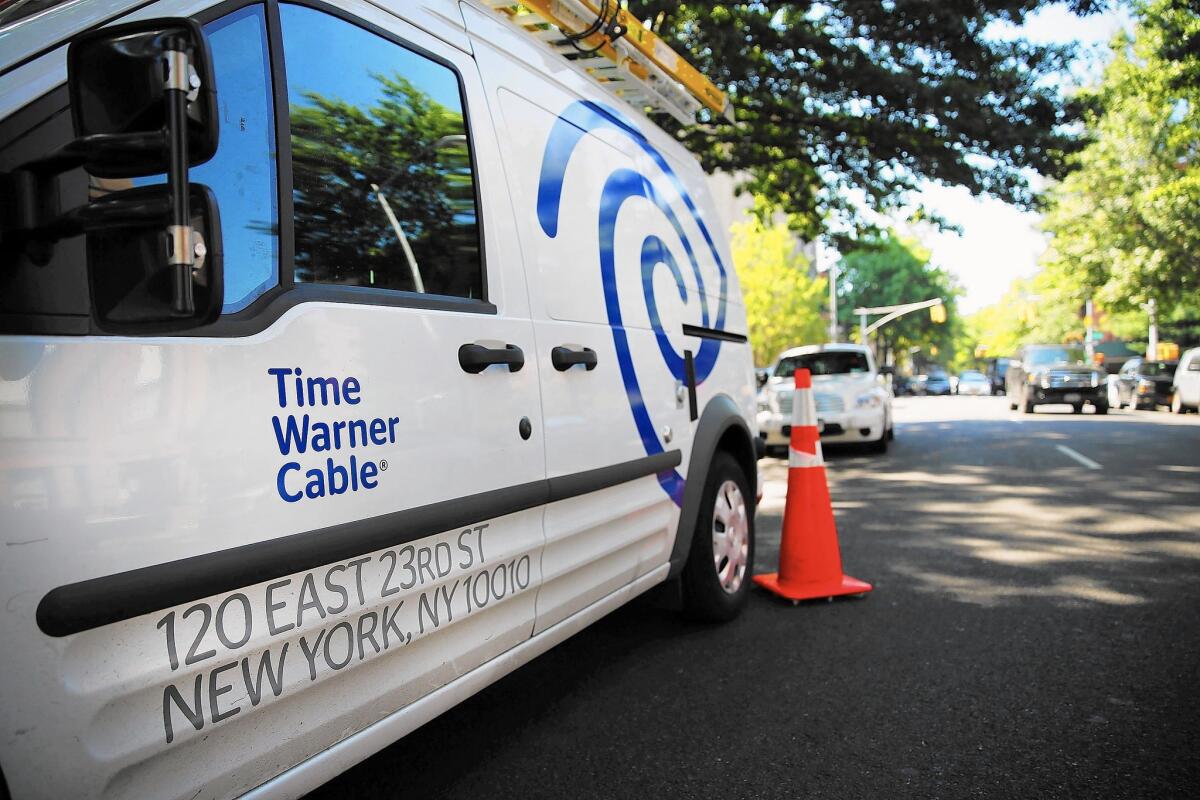Column: Time Warner Cable takes baby step toward more affordable pay-TV service

Time Warner Cable will test an online service that gets rid of the cable box and could pave the way for the introduction of smaller, more affordable, programming packages. Above, a company truck in Brooklyn, N.Y.
Dana Sutton is typical of many Time Warner Cable customers. It’s not that he dislikes the company’s services. He just doesn’t want so much of them.
For instance, the $12.75 a month he has to pay for his cable box. “That seems high,” Sutton, 73, told me.
Or the many, many channels he never watches. “I’d jump at the chance for a-la-carte channels,” the Corona resident said.
Could it be that Time Warner Cable feels his and others’ pain? I wouldn’t go that far. There’s a reason Time Warner was named in June the most hated cable company in America, according to the American Customer Satisfaction Index.
SIGN UP for the free California Inc. business newsletter >>
But Time Warner finally may be moving in the right direction.
The head of the company announced last week that Time Warner will test an online service that gets rid of the cable box and could pave the way for introduction of smaller, more affordable programming packages.
Ask Laz


The fast-food chain is acknowledging that soda isn't healthy

Addition of tech giant seen as making the index more diverse

'Handling' fees add up for consumers

Forbes says there's a record number of super-rich worldwide

Phone and cable companies set for years of litigation

Considered a black mark: Eating in the car

New FCC rules guarantee level playing field, more privacy

People should be mellow about yellow
“Where we’re headed,” Chief Executive Rob Marcus said, “is the ability of customers to access the complete video product without having to rent a set-top box from us.”
That doesn’t mean paying only for the channels you want, rather than the dozens you never watch. But it’s a baby step toward a kinder, gentler Time Warner Cable and indicative of moves the entire pay-TV industry is making to try to keep people from cutting the cord.
The no-box test is expected to begin next week in New York, a Time Warner spokesman told me. People with a Roku streaming-video device will be able to access Time Warner’s programming via an app similar to Netflix’s or Hulu’s.
If things go well in Gotham, Time Warner expects to expand the test to other cities and to other devices, such as video players from Apple, Amazon or Google. No information on pricing has been released.
CEO Marcus called the app technology “the next step in the evolution” of Time Warner’s pay-TV service.
That’s one way of putting it.
“They’re doing everything but a la carte,” said Craig Settles, a San Francisco Bay Area broadband consultant. “But they’re just putting off when they’re either going to go out of business or give people what they want.”
Time Warner’s competitors are leading the way. Satellite provider Dish Network’s Sling TV already serves up a mini-bundle of 23 popular channels for $20 a month. Verizon’s FiOS service includes a Custom TV option of several dozen channels for about $55 a month, while Comcast’s Stream service includes HBO and local networks for $15 monthly.
With each of these services, you still need to pay separately for a broadband Internet connection, which, after introductory offers expire, can run $50 or more a month. But your monthly out-of-pocket cost will be significantly lower than if you paid for one of the bloated programming packages offered by pay-TV companies along with Internet access.
The average cable TV bill is now a record $99, according to a recent survey by Leichtman Research Group. With high-speed Internet, you could be looking at closer to $180 a month.
“Everyone wants a la carte,” Settles said. “The industry is fighting like crazy to prevent it, but it will lose.”
Canada, our enlightened neighbor to the north, was experiencing the same clash between frustrated pay-TV subscribers and an industry reluctant to change. The government finally laid down the law earlier this year.
By December 2016, it said, Canadian broadcasters will be required to offer an “entry-level television service” costing no more than $25 a month. It will feature local and educational channels.
Beyond that base service, Canadians will create their own viewing packages by selecting “reasonably priced” individual channels. The system has been dubbed “pick and pay.”
Can we expect a similar approach in the U.S.?
“The answer to that is yes — maybe,” said Matthew Spitzer, a law professor at Northwestern University who specializes in telecom regulation.
He said streaming services empower consumers to take control of their pay-TV diet, as well as empower content providers to do an end run around traditional delivery systems and form direct bonds with audiences.
“This means cable companies are casting around for how to stay relevant,” Spitzer said. “They’re trying to figure out what’s next.”
Time Warner’s no-box experiment is proof of that. The company, which lost 7,000 video subscribers but gained 232,000 Internet customers in the most recent quarter, is striving to keep pace with its fast-changing subscriber base.
For the time being, Time Warner will limit the new technology to its own Internet customers — that is, you couldn’t access Time Warner’s services using, say, a Verizon Internet connection. But the company says this could change.
Time Warner also will require that you still have a set-top box if you want digital-recording capabilities.
Marcus, the CEO, has to keep shareholders happy while also courting tech-savvy subscribers. “For all the talk about skinny bundles,” he said last week, “we’re doing pretty well offering a full video product.”
Pretty well, however, may no longer be good enough.
David Lazarus’ column runs Tuesdays and Fridays. He also can be seen daily on KTLA-TV Channel 5 and followed on Twitter @Davidlaz. Send your tips or feedback to [email protected].
MORE FROM LAZARUS:
Americans are paying more for broadband speed but getting less
How long can a car with a disabled placard take up a parking space?
The answer to your sleep problems probably isn’t found in a pill bottle
More to Read
Inside the business of entertainment
The Wide Shot brings you news, analysis and insights on everything from streaming wars to production — and what it all means for the future.
You may occasionally receive promotional content from the Los Angeles Times.











